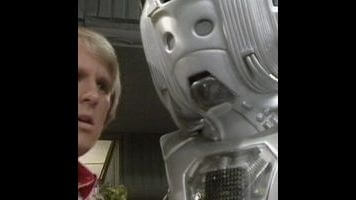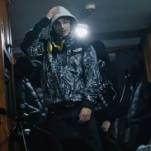Doctor Who (Classic): “The Dalek Invasion Of Earth”

“The Dalek Invasion Of Earth” (season 2, episodes 4-9. Originally aired Nov. 21-Dec. 26, 1964)
When it comes to its importance to Doctor Who, “The Dalek Invasion of Earth” is way up there among the most influential serials in its history. Commissioned almost immediately after the surprise smash hit of the Daleks’ debut the year before, “Dalek Invasion” put Who in the ratings top 10 for the first time, and helped stoke the fires of 1960s Dalekmania into a full-fledged craze. (Seriously, it was a big thing—not as big as Beatlemania, but a genuine pop-culture phenomenon.) It’s also hugely important to the show’s ongoing narrative—in their first story, the Daleks were implacably evil but still small-time, not even able to travel outside their home city. “Dalek Invasion” repositioned them as Doctor Who’s first and greatest intergalactic threat—and prompted a response in kind from its title character. With a bigger budget than ever before, “Dalek Invasion” boasted the series’ first extensive use of on-location filming, allowing real London landmarks to give the Daleks’ takeover an uncanny realism and an epic feel. And it marked another milestone first: The departure of a companion. The original companion, in fact—the Doctor’s granddaughter Susan, which set a precedent for how the series would work cast changes into the storyline.
Having said all that: “Dalek Invasion” has not aged well at all. In fact, it’s often a drag. Terry Nation’s script is frequently slow-paced and suffers badly from his penchant for deliberately running out the clock by throwing in long, meandering subplots. In “The Daleks,” he padded out the story by sending the characters on a long quest to get into the Dalek city by surprise. In this one, he splits the TARDIS crew up and sends them on three separate quests to get to Bedfordshire, the central nexus point of the villains’ master plan. There’s constant activity, but even though the characters are always moving, the story too often just spins its wheels.
Having said all that: It has an excellent beginning, opening on a shot of a creepily Orwellian sign reading “It Is Forbidden To Dump Bodies In The River.” Shuffling zombie-like past the sign is a distraught man in a bulky helmet—a Roboman, one of the Daleks’ enslaved and mind-controlled humans. He disobeys the sign by dumping himself in the river, committing a shocking and mysterious suicide by drowning. Then the TARDIS lands on the same spot, too late to save him or even know he was there.
Even though it’s set 200 years in the future, “Dalek Invasion” doesn’t really try to show a futuristic society—the humans drive ordinary vehicles, wear 20th-century clothing, and fight the Daleks with firearms instead of laser pistols. What it’s really trying to evoke is not the future but the past, or at least a possible past, imagining what it might have been like if England had lost World War Two and been annexed by Germany, with the Daleks sliding easily into the role of the Nazi occupiers. What happens to the humans is not a pretty picture: They either become collaborators (the Robomen), pathetically outmatched Resistance fighters, or opportunistic survivalists ready to sell anyone out for a bag of sugar. What the Daleks didn’t destroy outright, they corrupted. They’re creatures of the post-apocalypse, who learned to thrive in their devastated world on Skaro and recreated it for their convenience on Earth.
The first episode is mostly atmosphere and set-staging, as the Doctor, Ian, Barbara, and Susan explore what’s happened to the London of the 2160s, meet the human resistance fighters, and see the effects of the invasion before they know who’s responsible for it. This is very similar to the opening episode of “The Daleks,” which also took its time setting the scene before raising the stakes with the first appearance of the title monsters at the cliffhanger. The main difference here is that everybody watching knew what they were going to see—the Daleks were very much known quantities to viewers, and unlike the Cybermen in the Second Doctor’s “The Invasion,” their presence in the story wasn’t being kept back as a surprise. It’s right there in the title of the episode, after all. This cliffhanger is about anticipation, not surprise. You know a Dalek is going to show up, and the curveball Nation throws is how it shows up: Rising from the murky waters of the Thames, like Martin Sheen in Apocalypse Now.
Whatever you might have expected, it wasn’t that. (Although it does cleverly mirror the opening scene: First something sinks into the river, and now something nasty comes out.) It’s part of a larger strategy to beef up the Daleks’ threat level and give them an on-screen gravity that matched their outsized presence in wider pop culture. If you want to give their return a real sense of shock and menace, it’s a bold move to make them the new masters of Earth. And conceptually, it works—they’re mean, jumped-up bullies and this is perfectly in character for them. But it doesn’t work so well on a practical level. Earth has too many stairs for a conquering race with no legs. The Daleks’ tanklike shape is iconic and evocative of their brutal nature, but it only really works in the flat-surfaced environment it was designed for—their city on the planet Skaro, and the TV studio where it was built. Putting them on location in the London streets made their limitations hard to ignore.
With better special effects, the Daleks easily levitate or fly on new-series Who. But that wasn’t an option in 1964, and “Dalek Invasion” tries to jump that hurdle in two different ways. The first is by simply asserting forcefully that despite the evidence of your eyes, the Daleks are formidably mobile—that’s what the first cliffhanger is all about. If the Daleks can move around under rivers now, who knows what else they can do? And it works well enough that you do believe it—besides, you kind of have to accept it as a necessary premise of the story. But it still doesn’t overcome the storytelling problems of a faceless, armless, legless villain, and so the Daleks also were given human assistance in their Robomen, so they’d have someone who could do their dirty work.
Worse than the physical problems, though, is that Nation barely seems interested in the Daleks as characters, mostly using them as little more than generic thugs and oppressors. They don’t even say “Exterminate!” until the fifth episode. They’re gone from the story for long stretches, and in six episodes there are, if I’m counting correctly, zero scenes with any new insights into how Daleks think or what motivates them that we didn’t pick up from their first appearance. Sure, there’s superficial elements like the addition of a leader Dalek with a black shell—but a paint job is not the same thing as a characterization. Toward the end, we do get that delightfully crazy ultimate motivation of hollowing out the the Earth so they can drive it around the universe, but why they want to do that is left unexplored.








































